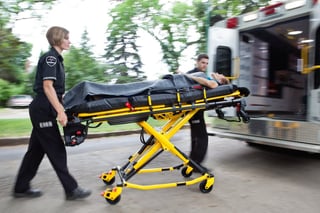 The moving and transport of trauma patients is never easy, especially if they're seriously injured, comatose or bariatric. It should go without saying that EMS and rescue personnel need to extricate and transport the injured patients without creating additional injury. An issue of great concern has been that of aggravating spinal injuries.
The moving and transport of trauma patients is never easy, especially if they're seriously injured, comatose or bariatric. It should go without saying that EMS and rescue personnel need to extricate and transport the injured patients without creating additional injury. An issue of great concern has been that of aggravating spinal injuries.
The traditional solution adopted is a rigid backboard. This has been thought to be able to adequately secure the patient and to immobilize the spine. Although practical, unfortunately, there's abundant evidence to suggest that backboards aggravate certain injuries, are painful and can affect normal respiration.
Protecting the Patient
When moving patients, it's important to do so in a manner that will avoid aggravating an existing injury or create additional injury and discomfort. This position statement by the National Association of EMS Physicians and the American College of Surgeons Committee on Trauma notes the following negative effects of using rigid backboards:
- Pain - "Existing painful conditions can be exacerbated and new pain can develop in areas that were not painful prior to the application of the backboard."
- Unnecessary Radiologic Exams - "Clinicians may be forced to perform imaging studies on areas that are painful solely due to the backboard, and not due to the initial injury."
- Respiratory Compromise - "For those patients with injury to the chest wall and lungs, backboard straps further interfere with respiratory mechanics; removal of these straps improves ventilation even in the face of such injuries."
- Pressure Sores - "Because the backboard is a rigid appliance that does not conform to a patient's body, patients develop pressure sores as a result of being immobilized on the backboard."
Protecting EMS Personnel
While EMS personnel are known for going the extra mile, this dedication leads to their undoing when they perform physical actions that demand too much of their bodies. Examples include:
- Transporting bariatric patients
- Lifting unresponsive patients
- Moving patients over obstacles and down slopes or stairs
- Carrying too heavy a load - over the recommended 35-pound limit
- Using bad or outdated lifting/moving techniques
According to the CDC, 21,300 EMS personnel suffered injuries in 2014:
- 35 percent of injuries caused by overexertion
- 16 percent from falls, slips or trips
- 34 percent resulted in strains and sprains
These figures illustrate the importance of safe working practices and why it's essential to use patient lifting and transport solutions that minimize strain.
Benefits of a Flexible Stretcher
A solution that's attracting a great deal of interest is the use of flexible stretchers, which are easy to maneuver and cause less patient trauma. A flexible patient transport system offers a number of tangible benefits over rigid solutions.
An example of such a system is the MegaMover®, which is manufactured from a strong, non-woven material. On either side, six padded handles allow a total of six responders to carry heavy patients. At either end, there are additional handles as well as pull straps. The stretcher carries 1,000 pounds and is large enough to wrap around bariatric patients.
The MegaMover stretcher is a better solution for preventing injuries for patients and EMS personnel because:
- Patients are comfortable and securely held
- The body assumes its normal shape
- The device is strong enough for the heaviest patient
- First responders share the weight load
- Multiple handles assist in difficult terrain
- It is easy to use in tight spaces
To find out about the MegaMover®, contact Graham Medical today.

